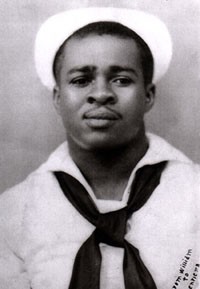William Pinckney facts for kids
Quick facts for kids
William Pinckney
|
|
|---|---|
 |
|
| Born | April 27, 1915 Dale, South Carolina, US |
| Died | July 21, 1976 (aged 61) Beaufort, South Carolina, US |
| Place of burial |
Beaufort National Cemetery, Beaufort, South Carolina
|
| Service/ |
|
| Years of service | 1938–1946 |
| Rank | Petty officer first class |
| Unit | USS Enterprise (CV-6) |
| Battles/wars | World War II
|
| Awards | Navy Cross Purple Heart |
William Pinckney (April 27, 1915 – July 21, 1976) was a brave United States Navy sailor. He was the second Black American to receive the Navy Cross. This award is the second-highest honor for courage in battle. Pinckney earned it for saving a shipmate's life. This happened on the USS Enterprise (CV-6) during the Battle of the Santa Cruz Islands. A Navy ship, the Arleigh Burke-class destroyer USS Pinckney (DDG 91), is named after him.
Contents
William Pinckney's Early Life
William Pinckney was born on April 27, 1915. His hometown was Dale, South Carolina. His father, Renty, built things for shrimp boats. William's mother, Jenny, passed away when he was eight. He went to school until the seventh grade. After school, he worked as a carpenter on shrimp boats, just like his dad.
Pinckney joined the Navy on August 3, 1938. He trained at Great Lakes, Illinois. Then, he became a cook on the aircraft carrier USS Enterprise (CV-6). At that time, being a cook was one of the few jobs Black sailors could have in the U.S. Navy.
While on the Enterprise, Pinckney was part of many important battles. These included the Doolittle Raid and the Battle of Midway. He also fought in the Battle of the Eastern Solomons. During this battle, the Enterprise was hit by three bombs. Seventy-four sailors died, and 95 were hurt.
After repairs, the Enterprise went to the Battle of the Santa Cruz Islands in October 1942. On October 26, the ship was hit again. Two bombs struck, killing 44 men and injuring 75. Pinckney's job during battle was in a room where ammunition was handled. One bomb hit the ship's flight deck. The explosion knocked Pinckney out. Four of the five other sailors in his room died.
When Pinckney woke up, the rooms around him were destroyed. He bravely made his way through the burning ship. He found an open hatch to the hangar deck. There, he saw the only other survivor, James Bagwell. Bagwell was unconscious and couldn't get up. Pinckney lifted Bagwell onto his shoulder. He started climbing the ladder to safety. On his first try, an electric cable shocked Pinckney. He was thrown back and knocked out again. When he woke up, he grabbed Bagwell once more. He carried him through the hatch to safety. After that, Pinckney went back down the hatch. He wanted to look for more survivors.
Pinckney was treated in Hawaii for his injuries. He had shrapnel wounds and severe burns. He then spent four years at Naval Base San Diego. He left the Navy on June 30, 1946. He was a Cook First Class. William Pinckney was one of only four African Americans to earn the Navy Cross during World War II.
After his Navy service, Pinckney worked for 26 years. He was a cook in the Merchant Marines.
Pinckney's Personal Life
William Pinckney met his future wife, Henrietta, in elementary school. He asked her to her first dance when she was fifteen. Eight years later, they married in Beaufort. The date was November 6, 1943.
Pinckney was also a Mason. He was a member of the American Legion. He passed away on July 21, 1976. He had been sick with spinal cancer for two years. He was buried in the Beaufort National Cemetery. His wife survived him. They did not have any children.
Years later, a historian named Larry Rowland found something important. Pinckney's headstone did not mention his Navy Cross. In 2018, a new headstone was put in place. It proudly listed his Navy Cross award.
Pinckney's Legacy and Honors
In 1943, when Pinckney received the Navy Cross, many newspapers wrote about it. Stories appeared in the New York Times and other papers. The Negro History Bulletin also covered his bravery.
A 1945 movie called The Negro Sailor showed Pinckney's heroism. It included a painting of him saving Bagwell's life. The film also honored other heroes like Doris Miller and Leonard Roy Harmon.
In the same year, Senator James M. Mead spoke about "Service of Negroes in the Navy." He read Pinckney's award details.
The Arleigh Burke-class destroyer USS Pinckney (DDG 91) is named in his honor. This ship was put into service on May 29, 2004. When the ship was named, the Secretary of the Navy, Richard Danzig, spoke about Pinckney. He said Pinckney showed "selfless service." This was true even when the Navy did not fully value Black service members. His willingness to give so much, even when he received little, made his actions even more heroic.
Images for kids
See also
 In Spanish: William Pinckney para niños
In Spanish: William Pinckney para niños



